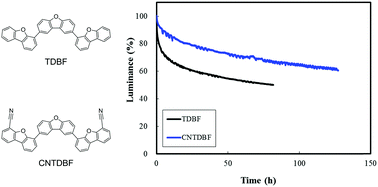Trisdibenzofuran-derived electron transport type exciton blocking materials for improved efficiency and lifetime in blue phosphorescent organic light-emitting diodes†
Abstract
Two trisdibenzofuran-derived compounds, 4,2′:8′,4′′-terdibenzo[b,d]furan (TDBF) and [4,2′:8′,4′′-terdibenzo[b,d]furan]-6,6′′-dicarbonitrile (CNTDBF), were developed and investigated as electron transport type exciton blocking materials of blue phosphorescent organic light-emitting diodes (PhOLEDs). TDBF was a trisdibenzofuran-type material without any substituent, and CNTDBF was a CN-modified trisdibenzofuran type material. The introduction of the trisdibenzofuran core provided a high triplet energy of more than 2.78 eV for use as an exciton blocking material in blue PhOLEDs, and the additional CN modification of the trisdibenzofuran moiety was effective for improved electron injection, electron transport and thermal stability and extension of the driving lifetime of the blue PhOLEDs. Among the two materials, CNTDBF provided a low driving voltage, a high quantum efficiency, a low efficiency roll-off and an extended lifetime.



 Please wait while we load your content...
Please wait while we load your content...